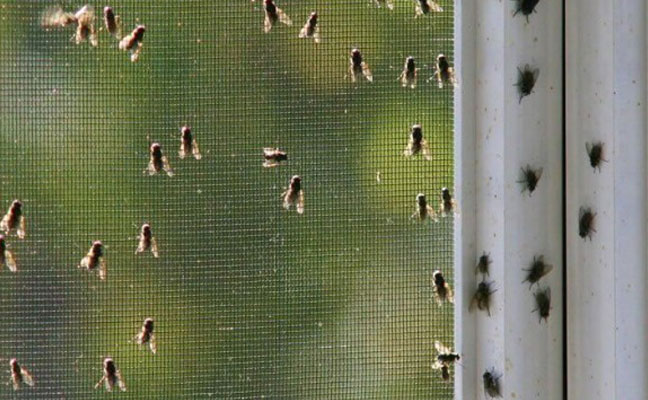Attics are a primary harborage for pests seeking shelter from the elements. This is especially true for stinging insects building a nest and for occasional invaders seeking an overwintering site in the fall. For PMPs, treating these pests in a confined attic space requires specific safety protocols and treatment strategies.
This article, part of our Top-floor tactics: The PMP’s ultimate guide to attic pest management, details the inspection and treatment protocols for wasps, hornets, carpenter bees, cluster flies, and other fall-invading pests.
Key takeaways
- Stinging insect safety: Wasp and hornet nests in attics are high-risk jobs. Always wear a full bee suit and have a clear exit path. Treat at night or in early morning when pests are less active.
- Carpenter bees: Look for their perfectly round, 1/2-inch-diameter holes in fascia boards, rafters, and eaves. Treatment involves applying dust to the galleries.
- Cluster flies: These flies overwinter in attics and voids. Treatment focuses on residual insecticides on south- and west-facing walls and using insect light traps (ILTs) in the attic.
- Occasional invaders: Pests like boxelder bugs and stink bugs are a nuisance but not destructive. Treatment involves perimeter sprays, exclusion, and vacuuming.

Paper wasps & hornets
Wasps and hornets often build their paper nests in the sheltered eaves and rafters of an attic. These are high-stakes jobs that require extreme caution.
Inspection cues for wasps & hornets:
- Nests: Look for the signature gray, paper-like nests, which can range from small, open-comb paper wasp nests to the large, enclosed globes of hornets.
- Activity: Observe for foraging pests flying in and out of attic vents or gaps in the soffit.
Treatment strategies for wasps & hornets:
- Safety first: Always wear a full bee suit, including a veiled hood and gloves. Ensure you have a clear, unobstructed exit path.
- Timing: Treat nests at night or in the very early morning, when the insects are less active and the full colony is present.
- Treatment: Use an aerosol knockdown agent for an initial kill, followed by an insecticidal dust applied directly to the nest and its opening.
- Removal: After confirming all activity has ceased (usually 24-48 hours), the nest can be safely removed.
Carpenter bees
While often seen as an exterior pest, carpenter bees frequently excavate their galleries in the fascia boards, soffits, and exposed rafters associated with an attic’s exterior.
Inspection cues for carpenter bees:
- Holes: Look for the perfectly round, 1/2-inch-diameter entrance holes.
- Frass: Piles of coarse “sawdust” (frass) may be seen on the ground or surfaces below the nest opening.
- Stains: Yellowish-brown stains may be visible around the entrance hole.
Treatment strategies for carpenter bees:
- Dust: The most effective treatment is to apply an insecticidal dust (such as boric acid or a non-repellent) directly into the gallery openings.
- Plug: After the bees have been eliminated, the holes should be sealed with a wood plug, caulk, or putty to prevent re-infestation.

Cluster flies
Cluster flies are a common fall-invading pest that enters structures in large numbers to overwinter, often choosing attics and wall voids as harborage.
Inspection cues for cluster flies:
- Masses: Look for large aggregations of sluggish flies, especially in high corners, around windows, and in voids.
- Timing: They are most noticeable on warm, sunny days in late fall or early spring.
- Location: They are often found on the south- and west-facing (sunny) sides of a structure.
Treatment strategies for cluster flies:
- ILTs: Insect light traps (ILTs) placed in the attic can capture a significant number of flies.
- Residuals: Apply a residual liquid or microencapsulated insecticide to areas where flies are landing.
- Exclusion: The most effective long-term control is to seal exterior cracks and crevices before the fall.
Occasional fall invaders (boxelder bugs, stink bugs, etc.)
Like cluster flies, these pests enter attics in the fall seeking a place to overwinter. While they don’t cause structural damage, they can be a major nuisance when they emerge inside the living space.
Inspection cues for fall invaders:
- Aggregations: Look for large numbers of these pests congregating in warm, sunny spots on the exterior and in protected corners, window frames, and light fixtures inside the attic.
Treatment strategies for fall invaders:
- Vacuuming: For existing infestations in the attic, mechanical removal with a vacuum is the best first step.
- Perimeter sprays: Apply a residual insecticide to the building’s exterior in late summer/early fall, focusing on the south and west walls and around entry points.
- Exclusion: Sealing gaps around windows, doors, utility lines, and vents is the key to prevention.
Conclusion
Managing stinging and fall-invading pests in attics requires a multi-faceted approach. For stinging insects, safety and proper PPE are paramount. For fall invaders, the strategy is a combination of interior removal and exterior prevention, with a strong focus on exclusion to provide a long-term solution for the client.
Explore the full attic pest guide
This article is the central hub for our complete guide to attic pests. Dive deeper into specific control strategies for the pests you encounter most often.
- Attic pest guide (Part 1): Wood-destroying insects
- Attic pest guide (Part 2): common and fabric pests
- Attic pest guide (Part 3): Stinging and fall-invading pests
- Attic pest guide (Part 4): Rodents and wildlife
- Attic pest guide (Part 5): Birds and associated pests
- Attic pest guide (Part 6): Six reasons why pests love attics
Leave A Comment